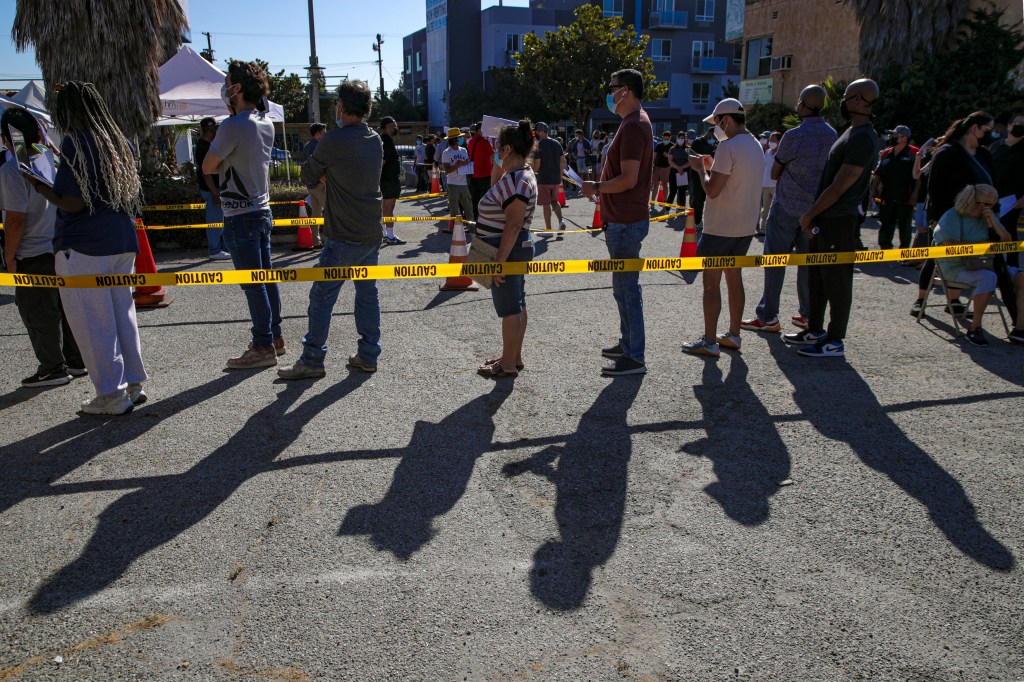Los Angeles County health officials found out Tuesday that the federal government slashed the county’s requested and expected monkeypox vaccine allotment by 60%.
Last week, the FDA told health care providers to split a one-dose vial of the monkeypox vaccine into five doses. The shift was good news for vaccine-strapped cities throughout the country because it meant what little supply is available could be stretched much further.
But then L.A. County and other cities and states were told that they would get significantly less vaccine than they’d requested. L.A. County expected to receive 14,000 vials of the vaccine this week, which would have yielded, when split, 70,000 doses for eligible residents. Instead, the county will receive 5,600 vials, which will yield only 28,000 doses.
At a news conference last week, L.A. County health officials said they expected the full shipment and with it could fully vaccinate up to 90,000 people — about half of what it believes to be the at-risk population. Now with far fewer vaccine doses, that goal may take weeks to achieve.
Monkeypox cases in L.A. County have climbed to more than 990. Most cases are among men who have sex with men. California has reported 2,358 cases statewide, ranking it second among states in case numbers after New York, according to the Centers for Disease Control and Prevention.
The vaccine, named Jynneos, is a smallpox vaccine that can also be used to prevent monkeypox amid the ongoing outbreak. The full-vial dose is injected into muscle tissue, but giving a smaller dose between layers of the skin — known as an intradermal injection — is also effective in preventing the painful viral infection.
The shift by federal officials from allotting vials to allotting doses took local public health officials by surprise. The Administration for Strategic Preparedness and Response within the Department of Health and Human Services is responsible for vaccine distribution.
Other places with active outbreaks also got word to expect significantly fewer vaccine vials in the next shipments. Philadelphia officials expected to receive 3,600 vials but will instead receive just over 700.
“We have thousands of people who are at risk that should be vaccinated preventively before they get exposed,” Philadelphia Health Commissioner Dr. Cheryl Bettigole said Tuesday. “We are advocating to our federal partners to reconsider and restore Philadelphia’s allocation of vaccine, which is urgently needed.”
L.A. County was an early adopter of the new dosing and injection strategy.
“We communicated that Public Health would implement these changes when the next tranche of doses were received, but if providers felt ready to implement the new strategy, they could proceed,” said the department’s statement.
The L.A. County Public Health department said it received assurances from federal leadership that more doses would be available in the coming weeks. But fewer doses means eligibility for the scarce vaccines will remain tight.
L.A. County has a population of 10 million people, and public health officials estimate about 180,000 are at elevated risk for monkeypox. The virus causes painful skin lesions and is spread through skin-to-skin contact with someone who has the lesions. Although anyone can contract monkeypox, gay and bisexual men who have had multiple partners in the past two weeks are at the highest risk in this outbreak. The U.S. has more than 13,500 identified cases as of Aug. 17, according to the CDC.
This story is part of a partnership that includes KPCC/LAist, NPR, and KHN.



